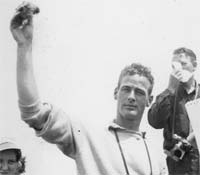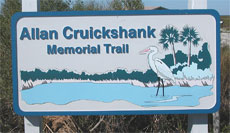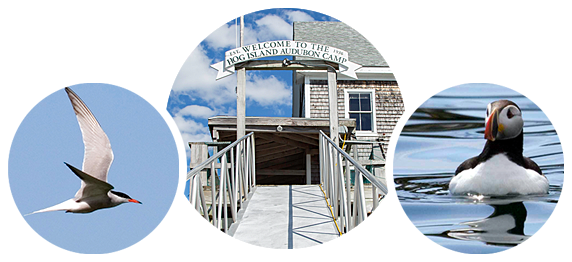By Tom Schaefer
Whether my bark went down at sea
Whether she met with gales
Whether to isles enchanted She bent her docile sails
By what mystic mooring She is held today
This is the errand of the eye Out upon the Bay.
— Emily Dickinson
Space shuttle Discovery returned to Earth early one morning in August 2005, not where families hoped it would — in the heart of a Florida wetland — but in the safe-enough California desert, among friends. I tried to interest my grandsons in the historic Return to Flight. They were both somewhat interested, the four year-old more so than the one twice his age who seemed more occupied with military aircraft and Star Wars battles.
The Hog Island Audubon Camp is connected to significant threads in American literature, nature study, ornithology, and now, would you believe, space.
I started visiting NASA’s Return to Flight Web site months prior, trying to learn of space shuttle upgrades that showed the learning curve of both aeronautical engineers and human resource people. I downloaded a few images for computer slideshows to be shared with the kids and read what I could understand. In the time waiting for the shuttle launch, we followed the celestial exploits of Martian rovers, the imaging of Jovian moons, close-ups of Saturn’s rings, and the crash landing of an interplanetary probe intent on learning the content of comet dust. All this follows by just a couple years the local and global celebration of the Wright Brothers’ first flight, much of it here in my hometown of Dayton, Ohio, where I heard one of my heroes, John Glenn, say that we needed to work harder in the sciences and in aeronautical research because of, at least in part, what we didn’t yet know of the capability of a hummingbird hovering and pelicans drafting, for great distances, only a wing tip away from saltwater.
All this has to do with connections. Syzygy, if you will. The lining up of celestial bodies, or in this case, the lining up of seemingly unrelated significant events that create a meaningful thread of, well, connections.
One of my first experiences with syzygy tapping me on the shoulder was rooted on Hog Island at the Audubon Camp in Maine twenty-five years ago. At the time I was a junior high English teacher beginning work on a master’s degree who was lucky enough to have the Dayton Audubon Society grant him a scholarship to the Audubon Ecology Camp in Maine, as the operation on Hog Island was called then. It just so happened that I was taking an Emily Dickinson workshop that spring when the scholarship interview and application process was taking place. Somebody in my class mentioned visiting Walt Whitman’s house and I came to think how cool it would be to visit Emily’s place on the way to the camp in Maine. I had developed a great interest in Dickinson during the graduate workshop class and so when the itinerary for my family’s travel from Ohio to Down East was finalized, it included a stop in Amhert, Massachusetts for a short visit to the Dickinson homestead.
Although the stop in Amherst was a bit disappointing at first, having learned while we stood on the front porch that the house was closed to visitors that day — a fact that eluded me in those pre-internet days — walking the grounds and observing the flower beds in that private place the introvert poet knew intimately just over a century prior was quite something. I did not get a look inside Emily’s house on that trip, but I was permitted a peek into her family’s secluded garden. And since I must admit there is much in Dickinson’s poetry I have a hard time understanding, just a peek at her “unfading flowers” was plenty to appreciate. Before the day was out, I dragged my wife and two daughters to the Dickinson burial plot a few blocks away. It was there, in meditation with my 35 mm camera and a couple of rolls of black and white and slide film, that I recorded a series of pictures of the shadows setting across her grave stone that still comprise a favorite collection in my personal portfolio.
But back to syzygy. A couple days following my Dickinson pilgrimage, I found myself on the mainland dock at the end of Keene Neck Road in Bremen, waiting for the launch piloted by a very friendly boatman named Joe, dressed in Audubon khaki, to take me the few hundred yards across the Hockomock Narrows to the Hog Island camp. Perhaps you have a personal appreciation for the beauty of the sea, maybe even for the unique waterscape of Muscongus Bay. This Midwesterner was in sensory overload. The texture of the water, the intensity of that August sky, the freshness of the bay breeze, the diversity of hues in the lobster buoys, the strangeness of cormorants and harbor seals, enhanced to the promise of time to be spent on this bay-bound island.
One of my goals during that two-week session was to conjure what my graduate “project” would be. The interdisciplinary humanities program I was working in was to culminate in the creation of some sort of product to be decided between my academic advisors and me. I was leaning toward literature, but also history. In my coursework up to that time, I found myself researching the history of the conservation movement in the United States. Surely the Hog Island muses would provide me with something juicy to chew on back home that could sustain me through the grueling nine hour project that awaited me. Enter my first appreciation of syzygy.
Within a couple of hours of my Audubon Camp arrival, after prowling around the building complex on island’s northern peninsula before the formal program began, I was stunned to realize the ‘savior’ of the island in the early 1900s was none other than Mabel Loomis Todd, the original editor of the Emily Dickinson poetry. Could it be that my academic pursuit in Ohio was connected to both Amherst and Hog Island on an intellectual and metaphysical thread spanning almost a century and over eight hundred miles? Indeed it had. Four years later I presented a copy of my project, The Epic of Hog: The Todd-Bingham Family and the Establishment of the Audubon Ecology Camp in Maine to camp director Steve Kress in a long-anticipated ceremony in the Fish House on the island.
Since that time I have quietly, and in awe, become an aficionado of personal syzygy. Which brings me back to Discovery’s Return to Flight. As it turns out, no comprehensive record of Hog Island history has been attempted to date. The saga of Audubon’s first nature camp, which was, in reality, its first nature center, as well, has been told piecemeal over the last seventy-plus years. The first definitive piece, published in 1936 in Natural History magazine, was authored by Millicent Todd Bingham, Mabel Todd’s daughter. It was Millicent Bingham who, after her mother’s death in 1935, while searching for a university to create a field research station on Hog Island, found National Audubon’s president John Baker. It just so happened that Baker was looking for a new venture in which teachers and students of nature study would be instructed in the new scientific field of ecology. The Point Breeze Inn on Hog Island was easily converted to the Audubon Camp and the seasonal operation opened the following summer. Along with Roger Tory Peterson, the other ornithology instructor in 1936 was Allan D. Cruickshank.

So in the spirit of learning more about the long reach of the Hog Island Audubon Camp, I found myself doing a Google search of Cruickshank on another morning last summer while watching Discovery attempt to launch on NASA TV. Just beside those pre-launch images, in another computer window, I learned that Cruickshank published a handful of books, including The Pocket Guide to Birds, Wings in the Wilderness, and 1001 Questions Answered About Birds. Some of his best photographs, a few hanging throughout the Hog Island camp building complex, were also published, including the images in Bird Islands Down East, written by his wife, Helen.
While all of this was relatively interesting on the day America’s shuttle fleet attempted to return to space, Hog Island syzygy surprised me once again. It turns out that Audubon’s own Allan D. Cruickshank single handedly convinced NASA in 1962 to turn over areas of the Kennedy Space Center not used by the space program to the U.S. Fish and Wildlife Service to incorporate the Merritt Island National Wildlife Refuge. Having used those wetlands for bird watching, film making, and photography, Cruickshank convinced NASA, hot into a space race with the Soviet Union, to preserve the unused spaceport buffer zone ecosystem.

The Hog Island Audubon Camp, moored mystically “out upon the Bay,” as Dickinson wrote of her metaphorical boat, has proven to be a point of alignment along more than one vector of syzygy. Finding connections to Hog Island tethered in various places, including its mention in Rachel Carson’s Silent Spring, confirms the impact and reach of the program on the island now run by the Maine Audubon Society. The Hog Island Audubon Camp is connected to significant threads in American literature, nature study, ornithology, and now, would you believe, space. Through Emily Dickinson, to Mabel Loomis Todd, to the Hog Island Audubon Camp, through Allan D. Cruickshank, then on to the Merritt Island National Wildlife Refuge, and finally into Earth orbit. Hog Island syzygy, indeed.
Tom Schaefer is chair of the Hog Island History Project which would appreciate stories of important people, places, or events connected to the Hog Island Audubon Camp. Contact the author for more information.

